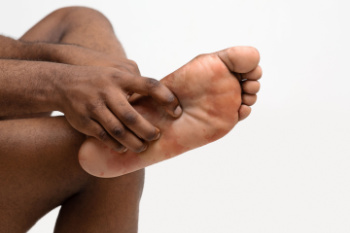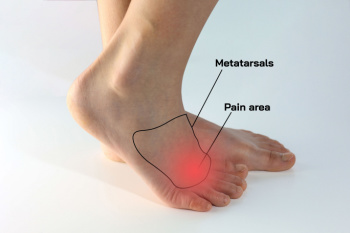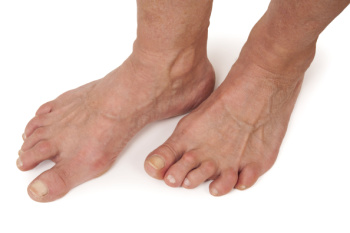Connect With Us
Blog

Pain from plantar fasciitis develops when the thick band of tissue running along the bottom of the foot becomes irritated or inflamed. This fascia connects the heel bone to the toes and supports the arch with every step. Common causes of plantar fasciitis include repetitive stress from long-distance running or standing for extended periods of time, as well as sudden changes in activity levels. Wearing shoes that lack adequate support, frequently using flip-flops, or walking barefoot on hard surfaces can also place additional strain on the heel. Structural factors such as flat feet or very high arches may increase pressure. Tight calf muscles and a shortened Achilles tendon can limit flexibility and pull excessively on the fascia. Over time, small tears may form, creating persistent heel pain that is often most noticeable first thing in the morning. A podiatrist can identify the underlying cause and recommend the best treatment. If you are experiencing symptoms of plantar fasciitis, it is suggested that you schedule an appointment with a podiatrist.
Plantar fasciitis is a common foot condition that is often caused by a strain injury. If you are experiencing heel pain or symptoms of plantar fasciitis, contact Emil Babayev, DPM from New York. Our doctor can provide the care you need to keep you pain-free and on your feet.
What Is Plantar Fasciitis?
Plantar fasciitis is one of the most common causes of heel pain. The plantar fascia is a ligament that connects your heel to the front of your foot. When this ligament becomes inflamed, plantar fasciitis is the result. If you have plantar fasciitis you will have a stabbing pain that usually occurs with your first steps in the morning. As the day progresses and you walk around more, this pain will start to disappear, but it will return after long periods of standing or sitting.
What Causes Plantar Fasciitis?
- Excessive running
- Having high arches in your feet
- Other foot issues such as flat feet
- Pregnancy (due to the sudden weight gain)
- Being on your feet very often
There are some risk factors that may make you more likely to develop plantar fasciitis compared to others. The condition most commonly affects adults between the ages of 40 and 60. It also tends to affect people who are obese because the extra pounds result in extra stress being placed on the plantar fascia.
Prevention
- Take good care of your feet – Wear shoes that have good arch support and heel cushioning.
- Maintain a healthy weight
- If you are a runner, alternate running with other sports that won’t cause heel pain
There are a variety of treatment options available for plantar fasciitis along with the pain that accompanies it. Additionally, physical therapy is a very important component in the treatment process. It is important that you meet with your podiatrist to determine which treatment option is best for you.
If you have any questions, please feel free to contact our offices located in Midwood and Kensington in Brooklyn, NY . We offer the newest diagnostic and treatment technologies for all your foot care needs.

Morton’s neuroma, also called a plantar digital neuroma, is a painful condition caused by the thickening of tissue around a nerve between the toes, most commonly between the third and fourth toes. It often develops from pressure, irritation, or injury to the nerve. Risk factors include wearing tight shoes or high heels, engaging in high-impact sports, and having foot deformities, such as flat feet or high arches. Many people notice symptoms that may include sharp, burning pain in the ball of the foot, tingling, or the feeling of a pebble inside the shoe. A podiatrist can provide an accurate diagnosis, orthotic support, and treatment options to relieve pain and prevent recurrence. If you have pain in this part of your foot, it is suggested that you schedule an appointment with a podiatrist who can provide effective treatment solutions.
Morton’s neuroma is a very uncomfortable condition to live with. If you think you have Morton’s neuroma, contact Emil Babayev, DPM of New York. Our doctor will attend to all of your foot care needs and answer any of your related questions.
Morton’s Neuroma
Morton's neuroma is a painful foot condition that commonly affects the areas between the second and third or third and fourth toe, although other areas of the foot are also susceptible. Morton’s neuroma is caused by an inflamed nerve in the foot that is being squeezed and aggravated by surrounding bones.
What Increases the Chances of Having Morton’s Neuroma?
- Ill-fitting high heels or shoes that add pressure to the toe or foot
- Jogging, running or any sport that involves constant impact to the foot
- Flat feet, bunions, and any other foot deformities
Morton’s neuroma is a very treatable condition. Orthotics and shoe inserts can often be used to alleviate the pain on the forefront of the feet. In more severe cases, corticosteroids can also be prescribed. In order to figure out the best treatment for your neuroma, it’s recommended to seek the care of a podiatrist who can diagnose your condition and provide different treatment options.
If you have any questions, please feel free to contact our offices located in Midwood and Kensington in Brooklyn, NY . We offer the newest diagnostic and treatment technologies for all your foot care needs.

Rheumatoid arthritis is an autoimmune condition that can cause inflammation in the small joints of the toes, leading to pain, stiffness, swelling, and deformity. It occurs when the immune system mistakenly attacks the lining of the joints, resulting in joint damage over time. In the toes, this may feel like a deep aching pain, often worse in the morning or after periods of rest. The toes may appear swollen, red, and may develop visible deformities, such as hammertoes or bunions. Walking can become painful, and wearing shoes may be difficult due to pressure on the joints. A podiatrist can assist with diagnosis through a clinical evaluation, medical history, and lab tests or imaging. Treatment may include custom orthotics, footwear modifications, and anti-inflammatory medications. In advanced cases, surgery may be considered. To manage symptoms and preserve mobility, it is suggested that you make an appointment with a podiatrist.
Because RA affects more than just your joints, including the joints in your feet and ankles, it is important to seek early diagnosis from your podiatrist if you feel like the pain in your feet might be caused by RA. For more information, contact Emil Babayev, DPM of New York. Our doctor will assist you with all of your podiatric concerns.
What Is Rheumatoid Arthritis?
Rheumatoid Arthritis (RA) is an autoimmune disorder in which the body’s own immune system attacks the membranes surrounding the joints. Inflammation of the lining and eventually the destruction of the joint’s cartilage and bone occur, causing severe pain and immobility.
Rheumatoid Arthritis of the Feet
Although RA usually attacks multiple bones and joints throughout the entire body, almost 90 percent of cases result in pain in the foot or ankle area.
Symptoms
- Swelling and pain in the feet
- Stiffness in the feet
- Pain on the ball or sole of feet
- Joint shift and deformation
Diagnosis
Quick diagnosis of RA in the feet is important so that the podiatrist can treat the area effectively. Your doctor will ask you about your medical history, occupation, and lifestyle to determine the origin of the condition. Rheumatoid Factor tests help to determine if someone is affected by the disease.
If you have any questions, please feel free to contact our offices located in Midwood and Kensington in Brooklyn, NY . We offer the newest diagnostic and treatment technologies for all your foot care needs.

